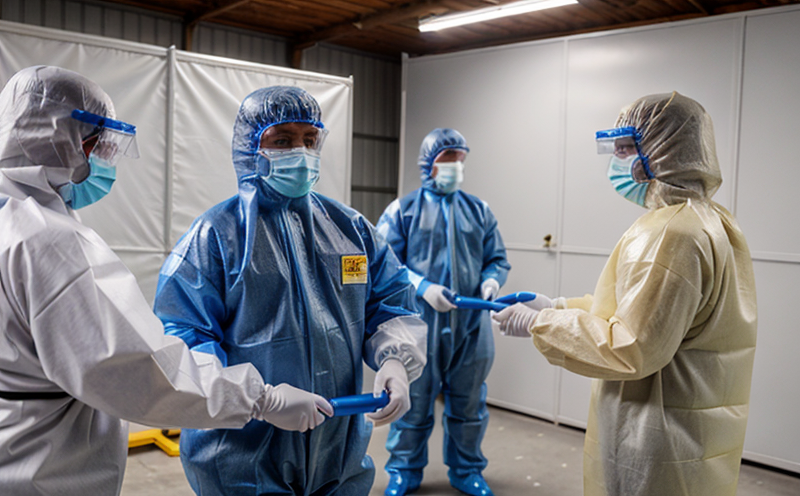NFPA 1971 Firefighting protective gear Structural performance testing
The NFPA 1971 standard is a critical framework that sets the benchmarks for structural performance in firefighting protective gear (PPE). This comprehensive service ensures that the garments meet the rigorous requirements necessary to protect firefighters from severe hazards, including heat, flame, and other physical threats. Compliance with this standard helps ensure firefighter safety while on duty.
The testing process involves several stages designed to evaluate various aspects of structural integrity and performance. Fabrication methods play a crucial role in determining how the material behaves under extreme conditions. For instance, the use of high-performance fibers like Kevlar or Nomex is essential for providing superior strength and thermal resistance.
In laboratory settings, we employ advanced equipment to simulate real-world scenarios that firefighters encounter during operations. This includes heat sources capable of reaching temperatures up to 1200°F (649°C) in order to assess the insulating properties of the fabric layers within the ensemble. The structural integrity test simulates a dynamic load by applying forces ranging from 500 pounds to 3,000 pounds at different points on the garment.
Another key aspect involves evaluating seam strength through tear tests and puncture resistance assessments. These tests are conducted using specialized machines that can measure stress concentrations around potential weak areas such as seams or zippers. Additionally, we analyze how well each component of the ensemble integrates with others via fit checks and movement evaluations to ensure they do not impede mobility.
Once all tests have been completed successfully, detailed reports are generated summarizing findings from both qualitative observations made during testing and quantitative data collected throughout procedures. Compliance certificates may also be issued if specified by customers or regulatory bodies like NFPA itself.
The importance of adhering to these stringent guidelines cannot be overstated given the life-threatening nature of firefighting activities. By ensuring that every piece of protective gear meets or exceeds established criteria, we contribute significantly towards safeguarding our brave frontline heroes who risk their lives daily for public safety.
Industry Applications
The application of NFPA 1971 structural performance testing extends beyond firefighting; it serves other industries where workers face similar challenges regarding protection against extreme conditions. For example, military personnel involved in rescue missions or hazardous material handlers might benefit from garments that provide equivalent levels of safety and durability.
In addition to the inherent benefits provided by meeting NFPA 1971 standards, adopting this approach can lead to cost savings over time due to reduced incidents requiring replacement gear. Moreover, having compliant products enhances brand reputation among stakeholders who prioritize employee health and well-being.
From a strategic standpoint, organizations implementing robust testing protocols not only enhance operational effectiveness but also demonstrate their commitment to maintaining high standards across all facets of business operations. This aligns perfectly with broader corporate goals related to corporate social responsibility (CSR) initiatives aimed at fostering safer working environments globally.
Environmental and Sustainability Contributions
The production process for materials used in NFPA 1971 compliant protective gear has made significant strides towards sustainability. Manufacturers are increasingly focusing on using recycled content where possible, which reduces reliance on virgin resources while minimizing waste generation.
Achieving environmental certifications such as bluesign® or OEKO-TEX® further strengthens the commitment to green practices throughout supply chains. These credentials ensure that every step from raw material sourcing through manufacturing aligns with stringent ecological standards set forth by recognized authorities worldwide.
Furthermore, advancements in fabric technology have led to improvements in energy efficiency during use. Lighter yet more resilient fabrics require less fuel consumption when transporting personnel to disaster sites or hazardous locations. Additionally, they contribute positively towards reducing carbon footprints associated with production activities and end-of-life disposal practices.
Competitive Advantage and Market Impact
Meeting NFPA 1971 structural performance testing requirements provides several competitive advantages for manufacturers seeking to position themselves favorably within the market. Firstly, compliance ensures that products meet or exceed industry expectations regarding safety and reliability – factors that are paramount when dealing with high-risk occupations.
Secondly, achieving certification can open doors to new markets or regions where strict regulatory requirements apply. This is particularly true for international expansion plans aimed at entering countries like Japan, South Korea, Australia, New Zealand, and Europe which have stringent regulations governing PPE standards.
Lastly, maintaining a strong reputation based on quality and safety fosters customer loyalty and trust among end users who are more likely to choose brands that prioritize these values. This ultimately translates into higher sales volumes and enhanced brand perception within competitive landscapes.





